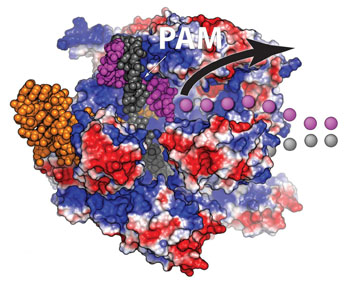Researchers Co-opt Slow DNA Release to Improve Accuracy of CRISPR/Cas9 Genome Editing
By LabMedica International staff writers
Posted on 31 Jan 2016
A careful study of the interaction of the Cas9 enzyme with target DNA has enabled genomics researchers to significantly improve the success rate of CRISPR-Cas9 gene editing.Posted on 31 Jan 2016
CRISPRs (clustered regularly interspaced short palindromic repeats) are segments of prokaryotic DNA containing short repetitions of base sequences. Each repetition is followed by short segments of "spacer DNA" from previous exposures to a bacterial virus or plasmid. CRISPRs are found in approximately 40% of sequenced bacteria genomes and 90% of sequenced archaea. CRISPRs are often associated with cas genes that code for proteins related to CRISPRs. The CRISPR/Cas complex comprises a prokaryotic immune system that confers resistance to foreign genetic elements such as plasmids and phages and provides a form of acquired immunity. Since 2013, the CRISPR/Cas system has been used in research for gene editing (adding, disrupting, or changing the sequence of specific genes) and gene regulation. By delivering the Cas9 protein and appropriate guide RNAs into a cell, the organism's genome can be cut at any desired location. The conventional CRISPR-Cas9 system is composed of two parts: the Cas9 enzyme, which cleaves the DNA molecule and specific RNA guides (CRISPRs) that shepherd the Cas9 protein to the target gene on a DNA strand.

Image: A view of the Cas9 protein (red and blue) bound to a double strand of DNA (purple and grey). After both strands are cut, one DNA strand (purple dots) is free and able to bind with a piece of DNA to be inserted at the break. This behavior can be utilized to significantly boost the efficiency of gene editing (Photo courtesy of Dr. Christopher Richardson, University of California, Berkeley).
Investigators at the University of California, Berkeley (USA) reported in the January 20, 2016, online edition of the journal Nature Biotechnology that dissociation of Cas9 from double-stranded DNA (dsDNA) substrates was slow (lifetime of about six hours) but that, before complete dissociation, Cas9 asymmetrically released the 3′ end of the cleaved DNA strand that was not complementary to the CRISPR sgRNA (guide strand). Taking advantage of this slow process, the investigators designed single-stranded DNA (ssDNA) donors of the optimal length complementary to the strand that was released first. This modification of the technique increased the rate of homology-directed repair (HDR) in human cells when using Cas9 variants to up to 60%.
"The exciting thing about CRISPR-Cas9 is the promise of fixing genes in place in our genome, but the efficiency for that can be very low," said senior author Dr. Jacob Corn, professor of biochemistry, biophysics, and structural biology at the University of California, Berkeley. "If you think of gene editing as a word processor, we know how to cut, but we need a more efficient way to paste and glue a new piece of DNA where we make the cut."
Related Links:
University of California, Berkeley













